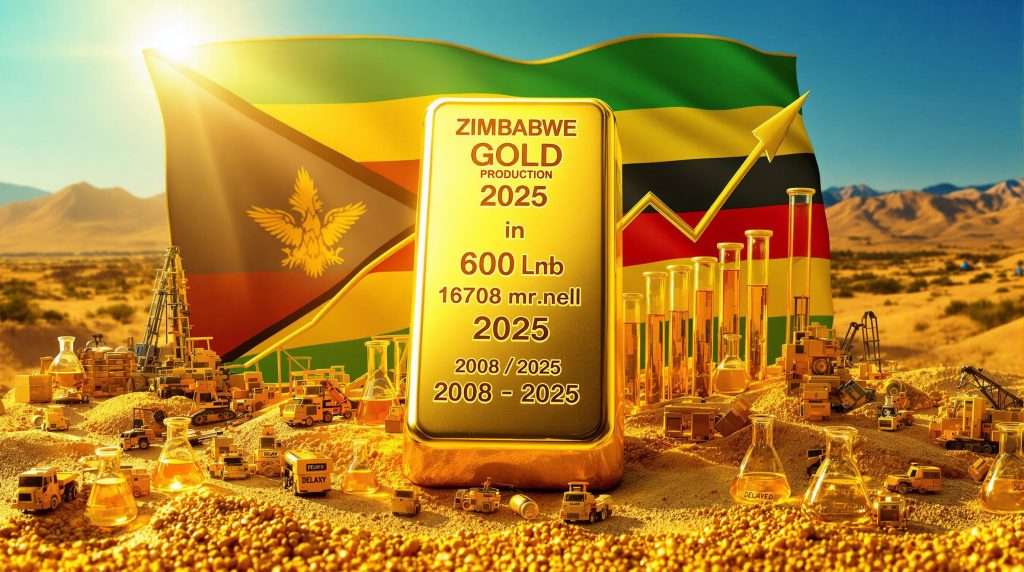Zimbabwe's Gold Rush: Record Prices and Exploration Boom Overwhelm Testing Labs
Zimbabwe's gold industry is experiencing unprecedented growth in 2025, with exploration activities surging to levels that have overwhelmed the country's laboratory infrastructure. This phenomenon reflects both global market dynamics and local economic resurgence, creating a unique moment in the nation's mining history. Zimbabwe labs overwhelmed as gold rally spurs exploration is becoming a defining narrative in the country's mining sector.
What Is Driving Zimbabwe's Gold Exploration Surge?
The perfect storm of global and local factors has catalyzed exceptional growth in Zimbabwe's gold sector, driving exploration to record levels and straining the country's supporting infrastructure.
Global Factors Behind Higher Gold Prices
Gold prices have skyrocketed to unprecedented heights, reaching a record gold price analysis showing $3,500 per ounce in April 2025, with futures trading around $3,410 as of August 2025. Several key factors have contributed to this remarkable price surge:
-
Geopolitical uncertainty has intensified worldwide, with international tensions and economic policy shifts—particularly new U.S. tariffs implemented in 2025—enhancing gold's traditional role as a "safe haven" asset.
-
Central bank purchasing has increased dramatically as national institutions seek to diversify reserves away from currency volatility, creating substantial additional demand.
-
Investment demand has grown as both institutional and retail investors seek inflation protection amid economic uncertainty.
These price signals have dramatically altered the economics of gold exploration and production, making previously marginal prospects highly attractive and spurring a worldwide hunt for new resources.
Local Dynamics in Zimbabwe
Zimbabwe's specific context has amplified the global gold rush within its borders:
-
Political and economic stabilization has created a more hospitable investment environment after years of suppressed output during periods of extreme volatility.
-
Regulatory improvements have begun addressing historical challenges that previously deterred international mining companies.
-
Under-explored geology presents exceptional opportunity, as Zimbabwe's gold potential remains significantly untapped despite its known mineral wealth.
As Craig Harvey, Vice President for Technical Services at Caledonia Mining Corp, noted: "This higher gold price environment has pulled the trigger on exploration. This bodes well for Zimbabwe, which is completely under-explored."
How Has Zimbabwe's Gold Production Changed?
The transformation of Zimbabwe's gold sector represents one of Africa's most remarkable mining revival stories, with production volumes that reflect profound industry rehabilitation.
Key Statistics: Zimbabwe's Gold Output and Growth
Zimbabwe's gold production has demonstrated extraordinary growth in recent years:
| Metric | 2008 | Jan–Jul 2024 | Jan–Jul 2025 | Est. Full-Year 2025 |
|---|---|---|---|---|
| National Gold Production (t) | 3 | ~17.36¹ | 24.3 | >40 |
| Year-over-year Growth (%) | — | — | +40% | New all-time high |
| Gold Price (April 2025, $/oz) | — | — | $3,500 | — |
¹ Approximate, calculated backward from 40% increase.
This production trajectory represents a remarkable recovery from the industry's nadir in 2008, when nationwide production collapsed to just 3 tonnes amid economic crisis. The expected 2025 full-year production of over 40 tonnes would establish a new historical high for Zimbabwe's gold sector.
Factors Driving Production Growth
Several key elements have contributed to this production renaissance:
-
Price incentives have made lower-grade deposits economically viable.
-
Operational improvements at existing mines have increased recovery rates and processing efficiency.
-
New project development has accelerated as capital becomes more readily available.
-
Artisanal mining formalization has brought previously unreported production into official channels.
This multi-faceted growth reflects both technical advances and policy improvements that have collectively transformed the industry's performance.
Why Are Zimbabwe's Laboratories Strained?
The gold exploration boom has revealed critical infrastructure constraints, with laboratory capacity emerging as a significant bottleneck in the development pipeline.
Causes of Laboratory Backlogs
Zimbabwe's laboratory infrastructure is struggling to keep pace with the unprecedented volume of mineral samples requiring analysis:
-
Exploration activity spike has generated sample volumes far exceeding historical norms as companies race to identify and quantify new resources.
-
Limited accredited facilities within Zimbabwe cannot process the current sample flow efficiently.
-
Technical complexity of modern exploration analysis requires specialized equipment and expertise that remains in short supply.
-
Quality assurance requirements for resource reporting standards mandate certified laboratory results, preventing shortcuts.
This bottleneck highlights how rapidly the sector has grown relative to its supporting infrastructure.
Impact on Mining Operations
The laboratory constraints are creating meaningful operational challenges:
-
Project timeline extensions as companies wait weeks or months longer than planned for critical assay results.
-
Exploration program adjustments as firms adapt to longer feedback cycles between drilling and results.
-
Investment delays as resource estimates and feasibility studies await necessary analytical data.
Craig Harvey of Caledonia Mining Corp acknowledged these challenges, stating: "It is very frustrating for us, but in the Zimbabwe context that's actually very encouraging." This perspective frames the laboratory bottleneck as a positive indicator of sector vitality rather than merely an operational hindrance.
Potential Solutions
Several approaches could address the laboratory capacity shortfall:
-
Capital investment in expanded laboratory facilities by either private providers or government institutions.
-
International partnerships with established laboratory networks to provide supplemental capacity.
-
Technology adoption to increase throughput and efficiency at existing facilities.
-
Training programs to expand the qualified technical workforce for laboratory operations.
These solutions require time to implement, suggesting the bottleneck may persist through at least the remainder of 2025.
Which Companies and Projects Are Shaping Zimbabwe's Gold Sector?
While numerous companies are participating in Zimbabwe's gold renaissance, several stand out for their contribution to the sector's transformation.
Caledonia Mining Corp's Performance
Caledonia Mining has emerged as one of the most significant success stories in Zimbabwe's gold sector:
-
Profitability surge: The company reported profits of $34.8 million in the first half of 2025, compared with $12.25 million in the same period of 2024—representing a 184% increase.
-
Production growth: Caledonia's flagship Blanket Mine has continued to increase output while maintaining cost discipline.
-
Exploration success: Despite laboratory delays, the company's exploration program has identified promising new resource areas with gold drilling results showing exceptional potential.
-
Strategic expansion: CEO Mark Learmonth has outlined plans to develop the Bilboes project into "potentially Zimbabwe's biggest gold mine" while exploring funding options that would "minimize equity dilution or impacting the company's dividend policy."
This performance exemplifies how higher gold prices combined with operational excellence can transform mining economics in the current market environment.
Emerging Industry Trends
Several key trends are becoming apparent across Zimbabwe's gold sector:
-
Consolidation opportunities are emerging as larger players seek to acquire promising projects from junior explorers.
-
Technological innovation is accelerating as companies implement advanced exploration and processing techniques.
-
Community engagement models are evolving to ensure local benefits from mining activities.
-
Sustainability initiatives are becoming increasingly prominent as companies recognize their importance for securing social license and meeting investor expectations.
These trends reflect the sector's maturation and integration into global mining best practices.
What Are the Major Challenges and Opportunities Facing Zimbabwe's Gold Industry?
Zimbabwe's gold sector faces a complex landscape of both obstacles and potential advantages as it continues its growth trajectory.
Key Pressure Points
Several challenges could constrain the industry's development if not effectively addressed:
-
Infrastructure limitations extend beyond laboratory capacity to include power supply reliability, water management, and transportation networks.
-
Capital access constraints persist despite improved investment sentiment, with many companies still facing high costs of capital relative to peers in more established mining jurisdictions.
-
Technical skill shortages in specialized areas from geology to metallurgy can delay project advancement and limit operational optimization.
-
Regulatory uncertainty remains a concern for some investors despite recent improvements.
These factors require coordinated attention from both industry and government stakeholders to ensure sustained sector growth.
Future Development Catalysts
Several promising developments could further accelerate Zimbabwe's gold sector evolution:
-
Laboratory capacity expansion is likely as market signals attract investment in this critical infrastructure.
-
International technical partnerships could bring advanced expertise and technology to address operational challenges.
-
Geological database enhancement would improve exploration efficiency and success rates.
-
Value chain development beyond primary extraction could increase domestic economic benefits from mining activity.
The sector's trajectory will depend significantly on how effectively these opportunities are leveraged to overcome existing constraints.
How Does Zimbabwe Compare With Other Gold-Producing Nations?
Zimbabwe's performance must be considered within the broader context of African and global gold market performance to properly assess its significance.
Comparative Gold Production Table (2025 Estimates)
| Country | Expected Output (t/year) | Year-on-Year Change (%) |
|---|---|---|
| South Africa | 110 | +4% |
| Ghana | 130 | +3% |
| Zimbabwe | 40+ | +40% |
| Mali | 70 | +0.5% |
While Zimbabwe's absolute production remains below that of Africa's largest gold producers, its growth rate significantly outpaces regional peers, highlighting the exceptional nature of its current mining renaissance.
Zimbabwe's Competitive Position
Several factors influence Zimbabwe's standing relative to other gold-producing nations:
-
Growth momentum is among the strongest globally, creating significant investment interest.
-
Resource potential remains substantial, with geological similarities to productive regions in neighboring countries.
-
Cost structure benefits from certain advantages including relatively skilled labor force.
-
Risk-reward profile continues to evolve as the country seeks to address historical challenges.
Zimbabwe's trajectory suggests potential for further gains in its relative position among gold-producing nations if current trends continue.
Frequently Asked Questions (FAQ)
What is causing record gold prices in 2025?
The gold record highs analysis shows that 2025's exceptional prices stem from a combination of heightened geopolitical risks, central bank accumulation for reserve diversification, inflationary concerns, and investment demand seeking safety amid economic uncertainty. The peak of $3,500 per ounce reached in April 2025 represents a historical high-water mark for the precious metal, as Bloomberg reports on Zimbabwe's gold wealth.
How long are lab delays impacting Zimbabwean miners?
While specific turnaround times vary by project and laboratory, mining executives report significant delays in receiving assay results from exploration activities. These delays are extending project timelines and complicating exploration program management, though they reflect the positive underlying trend of unprecedented sector activity.
Is gold exploration expected to continue increasing?
Current indicators suggest exploration activity will continue expanding as long as gold prices remain elevated and Zimbabwe's significant geological potential remains under-explored. The gold price forecast 2025 indicates continued upward momentum, creating strong incentives for further exploration growth.
What steps can address the lab bottleneck?
Addressing laboratory capacity constraints will likely require multi-faceted approaches including capital investment in expanded facilities, technological upgrades to improve throughput, workforce development to increase skilled personnel, and potential international partnerships to supplement local capacity. Both private and public sector initiatives may contribute to solutions.
Zimbabwe at the Forefront of the Gold Renaissance
Zimbabwe's extraordinary gold sector growth—from a low of 3 tonnes in 2008 to an expected 40+ tonnes in 2025—exemplifies how favorable market conditions combined with improving local factors can transform a nation's mining industry. The 40% year-over-year production increase recorded in early 2025 places Zimbabwe among the world's fastest-growing gold producers, despite infrastructure limitations that include laboratory capacity constraints.
The sector's growth has delivered substantial economic benefits, as demonstrated by Caledonia Mining's 184% profit increase in the first half of 2025. This financial performance enables further investment in projects like Bilboes, which has the potential to become Zimbabwe's largest gold mine.
While challenges remain in infrastructure development, capital access, and technical capacity, the fundamental drivers of Zimbabwe's gold boom—global price strength and geological potential—appear poised to sustain the sector's momentum. The laboratory bottleneck, while operationally frustrating, represents a positive indicator of extraordinary exploration activity that bodes well for future production growth.
As the gold renaissance continues, Zimbabwe has the opportunity to establish itself as an increasingly significant player in global gold markets, potentially climbing the ranks of African producers if current growth rates can be maintained through ongoing investment and development.
Disclaimer: This article contains forecasts and analysis of market conditions that are subject to change. Readers should conduct their own research and due diligence before making investment or business decisions based on the information presented.
Want to Know When the Next Major Gold Discovery Happens?
Stay ahead of the market with Discovery Alert's proprietary Discovery IQ model, which instantly notifies you about significant gold discoveries on the ASX before they make headlines. Visit the Discovery Alert discoveries page to see how past mineral discoveries have generated exceptional returns for early investors.




